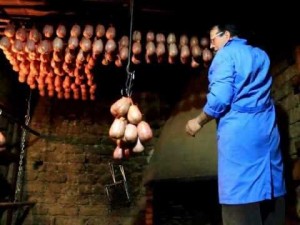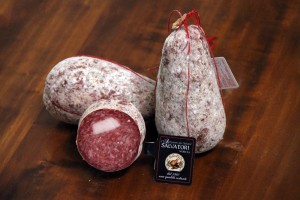Mule,s balls
Someone know them as Mortadella of Campotosto but their characteristics are very different from any type of mortadella.
Mule’s balls might seem like a dirty word, in fact it is if is intended in real etymological meaning of the word. In fact, the Mule’s balls, also known as Mortadella of Campotosto, is a meat much appreciated but little known, typical of the area surrounding Campotosto Lake in the province of L’Aquila.
The name Mule’s balls, it owes to the particular oval shape due to the packaging of meat in a gut still sewing by hand, and to be linked in pairs so they can be put to mature riding a rod or a perch wood.

For a long time, the nearby town of Amatrice, once part of the Abruzzo region, had appropriated the paternity of this meat. During the medieval period in fact, Amatrice dominated the surrounding territory and this also included the territories located near the lake.
From some years the mule’s balls are also found in the area of Norcia, famous for the butchery products but certainly many laboratories in the area have appropriated this production for an essentially commercial purpose.
In reality the tradition of the mule’s balls is very old, certainly linked to the peasant habit to kill the pig for family needs during the long cold winter of the mountain areas.
Currently its production is very limited and this characterizes it as a niche product available almost exclusively in the production area.
In fact it is made exclusively from pork that farmers and shepherds bred in the territory of the Monti della Laga, currently home to a natural park.

A further specific feature of this salami is that inside each casing, before filling, is inserted a finger of lard. This not only makes the mule’s balls unmistakable, gives them a special flavor and softness.
The preparation of the mule’s balls is done by using the lean pork meat of the shoulder, the loin and the trimming of ham, finely minced and seasoned with salt, pepper and white wine in which it was made an infusion of cinnamon and clove.
The mixture is then left to mature for at least 24 hours in traditional wooden containers called scifoni or in modern steel containers.
During the maturing, the mixture is mixed several times before bagging that takes place manually. Then binds the gut and with the same string you practice a gross tyings of the salami as if they were four cloves.
Once perforated the casing, to allow the removal of water during the curing, the salami, weighing approximately 4/500 grams, are tied in pairs and put to mature.
After a few days of drying, made near a fireplace fueled with wood from the surrounding forests, begins the real maturation period that can range from three to six months in the cold mountain air.
At the end of the curing period the salami, cut in section, shows a beautiful deep red color, a tiny marbling of fat and a white square formed by the finger of lard. The mule’s balls can be consumed naturally, accompanied by a good slice of bread of the area, made with sourdough, a prolonged natural leavening and baked in wood-burning stoves, but also after taking bath in red wine for a couple of days.
Source: cucinaconoi.it





Leave a comment